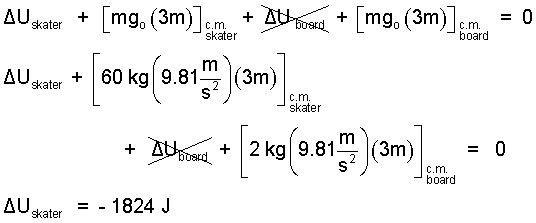| THERMO Spoken Here! ~ J. Pohl © | TOC NEXT ~ 150 |
Skateboard Skill

A feat of skate board competition called "to get air" happens when the skater tips into the ramp (1), gains momentum with the fall then rockets up the far side "getting air" or height above the half pipe rim (2). Skate boarders know "Air is not free."
What must a skate boarder "pay" to attain "three meters of air"?
♦ As system we select the person (60 kg) and the board (2 kg). The event initiates and ends with velocities equal to zero. Wind drag and rolling friction, the only boundary forces; we assume are negligibly small. Heats are inconsequential. Below Eqn-1 is the energy equation with our information included.

| (1)
System as person and skate board. |
Let's take the datum for potential energy at the initial level of the center of mass. Rewrite the equation.

| (2) 2 |
An answer is immediate but for the term, ΔU, of the board. The energy of the board is a function of its properties deflection and temperature. For the event, over the time increment (t2 - t1) the "flex" is zero then zero. Also, negligible temperature change is anticipated. Good boards act like springs. Skater-applied force will distort the board, elastically. Knowing the board will spring back to its original shape, the agile skater puts energy into the board while falling then retrieves it to advantage in upward flight. Skate boarders employ their skate boards in a similar manner, as pole-vaulter's do their poles and as bungee jumpers use bungee cords. Among equal competitors, he with the better skate board (pole or bungee cord) wins the competition.
In the equation assume internal energy change of the board of no help whatsoever. However the elevation change must be addressed. Thus the least energy change of skater is:

| (3) 3 |
The final form, Eqn-3, is appropriate. Our model is a closed system of two parts. To discuss further we rearrange ΔU for the skater only:

| (4) 4 |
The second internal energy of the person is less than the initial energy. So the "cost" of the feat to the skater is a reduction of internal energy. So one might say, "Where did that energy go?" It was initially within the skater as energy of motive ability, then finally there as fatigue. A more precise answer is difficult to state. This component of our syatem is a person. Simple thermodynamic analysis of human activity yields limited information (as shown here).
Skate Board Skill

A standard feat of skate board competitions is "get air" which means simply to "jump" in which the skater starts by tipping into the ramp (1), gaining momentum with the fall then "getting air" or height on the opposite side (2). Skate boarders know "Air is not for free."
What must a skate boarder "pay" to attain one meter of air (height)?
Premise presently unwritted!